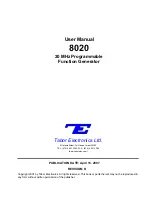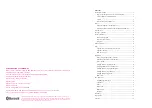
20
d.
Attach the DVM from P to VP on the rear panel.
e.
Adjust A2R23 (R-PROG F.S.) to 2.5V
±
4mV.
f.
Remember to reset MODE switches to original settings.
Performance Tests
The following paragraphs provide test procedures for verifying the unit’s compliance with the specifications of Table 1-1 in
the Operating Manual. Please refer to CALIBRATION PROCEDURE or TROUBLESHOOTING if you observe
out-of-specification performance. The performance test specifications are listed in the Performance Test Record in
Appendix C and D. You can record the actual measured values in the columns provided.
Measurement Techniques
Setup For All Tests. Measure the output voltage directly at the + S and - S terminals. Connect unit for local sensing, and
ensure that MODE switches are set as shown below. Select an adequate wire gauge for load leads using the procedures
given in the Operating Manual for connecting the load.
Electronic Load. The test and calibration procedures use an electronic load to test the unit quickly and accurately. If an
electronic load is not available, you may substitute:
2
Ω
200W load resistor (6033A).
18
Ω
200W load resistor (6038A).
for the electronic load in these tests:
CV Source Effect (Line Regulation).
CC Load Effect (Load Regulation).
You may substitute:
0.25
Ω
200W load resistor (6033A).
2.3
Ω
200W load resistor (6038A).
in these tests:
CV Load Effect (Load Regulation)
CV PARD (Ripple and Noise)
CC Source Effect (Line Regulation)
CC PARD (Ripple and Noise)
The substitution of the load resistor requires adding a load switch and making minor changes to the procedures. The load
transient recovery time test procedure is not amenable to modification for use with load resistors.
An electronic load is considerably easier to use than a load resistor. It eliminates the need for connecting resistors or
rheostats in parallel to handle the power, it is much more stable than a carbon-pile load, and it makes easy work of switching
between load conditions as is required for the load regulation and load transient-response tests.
Current-Monitoring Resistor. To eliminate output current measurement error caused by voltage drops in the leads and
connections, connect the current-monitoring resistor between -OUT and the load as a four-terminal device. Figure 2-4
shows correct connections. Connect the current-monitoring test leads inside the load-lead connections directly at the
monitoring resistor element.
Summary of Contents for 6038A
Page 4: ......
Page 8: ......
Page 34: ...34 Figure 3 1 Troubleshooting Isolation ...
Page 35: ...35 Figure 3 1 Troubleshooting Isolation continued ...
Page 37: ...37 Figure 3 3 Clock and Primary SA Waveforms ...
Page 40: ...40 Figure 3 4 Readback and Secondary SA Waveforms ...
Page 56: ...56 Figure 3 7 Waveforms ...
Page 62: ...62 Figure 4 1 HP IB Block Diagram ...
Page 65: ...65 Figure 4 2 Front Panel Block Diagram ...
Page 90: ......
Page 93: ...93 Figure 6 1 Top View Top Covers Removed ...
Page 94: ...94 Figure 6 2 Main Board A1 Component Location ...
Page 95: ...95 Figure 6 3 Control Board A2 Component Location ...
Page 96: ...96 Figure 6 4 Front Panel Board A3 Component Location ...
Page 97: ...97 Figure 6 5 Power Mesh Board A4 Component Location ...
Page 98: ...98 Figure 6 6 HP IB Board A8 Component Location ...
Page 105: ...105 Figure 3 1 Troubleshooting Isolation option 001 ...
Page 106: ......
















































